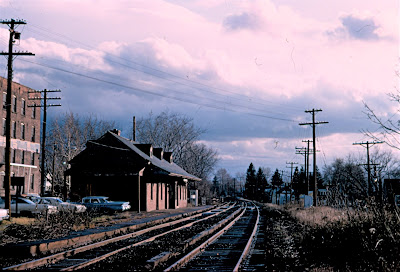Mail Service New Haven Style
A two-page article on moving mail by train. There is some interesting information on how mail is moved on trains, and it notes that there are 27 60-foot RPOs, 25 30' Compartment RPO/Baggage, and 5 15' Compartment RPO/Baggage cars. It notes that 263 trains are authorized for mail service, with 85 with RPOs, 46 with full-length storage cars, and the rest with lesser amounts of storage mail. Three trains, 179 and 181 Boston to Penn Station, and 180 in the reverse direction, have multiple RPOs. It is believed that Train 180 carries more mail than any other train in the world.
There was a 15' RPO on train 131/136 through New Britain, and Bethlehem Car works has a model (which I'll be building soon). The 60' RPO was available as a NHRHTA kit made by F&C and can be found on eBay from time-to-time. I have one partially built that will be going to Chris when I complete it since I won't need the 60' cars.
Nearly every passenger train through New Britain when hauled by locomotives carried storage mail in the baggage cars. In addition, a car was spotted at New Britain Station which went to Hartford each evening on Train 472. Steel baggage cars of two different sizes, with both clerestory roofs and turtle roofs, were also previously available from NHRHTA kits made by F&C. I have a couple that I started myself and a couple started by Ted Culotta to finish, plus two from Lee Ritchie's estate. In addition, Bethlehem Car Works makes kits for the wooden baggage cars. I have two of the kits, but the first release had incorrectly spaced doors. I started modifying mine, but will probably scratchbuild them instead, since I'd like to try scratchbuilding a few cars and they seem to be a relatively easy option.
Rug Cutting de luxe
As many of you know (and it's mentioned in my clinic on Prototype Modeling), I was originally building a layout featuring Windsor Locks and Thompsonville. Both towns featured a number of industries, but the largest was Bigelow-Sanford Carpet Co. This brief article provides some details about the business. Of particular interest is the indication that they are increasing capacity to 30,000 pounds of raw wool annually. Between Thompsonville (their headquarters) and Amsterdam, NY they are believed to have the greatest carpet-producing capacity in the world. In addition to handling freight, two passenger specials handle the annual employee outing to Rye, NY.
All carpet wools are shipped from Scotland, Ireland, India, China, Tibet, Iceland, New Zealand, Africa, Persia, Syria, and South America, and transferred to rail. Which means shipments from the California coast are just as possible as from New York, Boston, or the south.
Thompsonville itself is a very compact town to model, although the bulk of the traffic is Springfield - Hartford and/or New Haven passenger trains, usually a round trip hourly, if not more. Many of these are full length, 10-12 heavyweights, Pullman-Bradley lightweights, or the stainless steel cars depending on the era, with I-4 and I-5 steam locomotives, or a pair of DL-109s. So not short trains.
Main St. runs along the factory, and crosses under the railroad just south of the passenger station, and then crosses over the CT River. The passenger and freight stations are separated from the Bigelow-Sanford factory by Commerce St., but it really seems like little more than a driveway
Across the tracks is the International Casket Hardware Co., plus the Bigelow coal trestle and power house.
I was recently looking through these after I was contacted by Jim, who is modeling the Springfield line in N-Scale. One map in particular that I found very useful is of the station area with a diagram for a new oil unloading facility:
The map highlights how compact this scene is though, starting with a bridge over Main St., then the passenger and freight stations on one side, and International Casket Hardware Co on the other side, with the Bigelow-Sanford power house behind that.
George Ford Photos
Back when I was planning on modeling Thompsonville, George Ford was generous enough to loan me a series of photos and slides that he took 1968-1970. With his permission, I'll share some with here.
Here's the station, looking toward Springfield:






















No comments:
Post a Comment